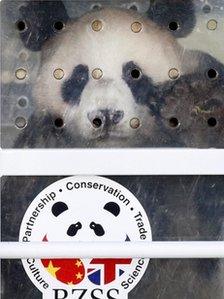Edinburgh Zoo pandas: Peeking at them in new home
- Published
A first look at the two giant pandas in their new home in Edinburgh Zoo
The two giant pandas which arrived in Edinburgh Zoo last week have been settling in to their new surroundings in different ways.
Yang Guang, the male, who is also known as Sunshine, has been exploring his enclosure and spending hours in full view of the zoo's keepers.
Tian Tian (Sweetie) has been more reticent and remains out of sight much of the time .
Television crews were allowed to film at the panda enclosures earlier.
Paying visitors will be allowed in to see the giant pandas for the first time on Friday.
It has taken five years of negotiations to bring the two giant pandas to Scotland.

The pandas were transported to Edinburgh from China by plane
They are on loan and will remain in Edinburgh until 2021, when they and any cubs will return to China.
It is a deal which could be of benefit to both sides.
Edinburgh Zoo will pay the Chinese the equivalent of $1m (£600,000) a year but has gambled the increase in entrance takings should cover that.
The zoo's chief executive, Hugh Roberts, has suggested interest in the pandas will surge, perhaps lifting visitor numbers by as much as 70% in the first year.
While the arrival of Tian Tian and Yang Guang has been widely welcomed, not everyone is convinced flying them 5,000 miles to Scotland from Sichuan Province is a good idea.
Some critics have complained the arrangement is commercial and has little to do with conservation.
Others have argued that the zoo may lose money, especially if the pandas fail to produce cubs.
The zoo has answers to both complaints, saying they are part of an international conservation effort.
In the West, panda-mania goes back nearly 100 years.
A German zoologist managed to buy a cub in 1916.

Each enclosure has a water feature and climbing structures made out of tree trunks
Twenty years later, another cub was brought to the USA from China and went on display in a zoo in Chicago.
However, it was not until the 1970s that panda diplomacy became part of China's relations with other nations.
US President Richard Nixon secured a pair of giant pandas from the People's Republic of China in 1972.
The reaction to the gift in America was so enthusiastic, First Lady Pat Nixon termed it "pandamonium".
I had my own, unplanned encounter with China's pandas in 1988.
As a correspondent based in Peking (as we then knew it) I had managed to get on a flight to Tibet.
It was not easy to arrange and I did not relax until the plane was in the air and heading west.
But I had not bargained for the vagaries of the Himalayan weather which turned so bad, the pilot diverted to Chengdu in Sichuan.
I hadn't expected to be there but I did know Sichuan was the home of the giant pandas.

Panda merchandise has been on sale at Edinburgh zoo for weeks
I hired a bike and rode out to the zoo where there were at least a dozen pandas in open cages.
As visitors to Edinburgh zoo will discover, they do not do much but there is nothing else in the world quite like them.
It took years of academic discussion to decide if they were members of the bear or the racoon family.
They are bears.
They have been around for two or three million years so they are living fossils.
The reason they are close to extinction is that they have wandered down an evolutionary dead-end.
Giant pandas have come to depend almost entirely on bamboo and the forests which could sustain them are shrinking.
The positive side of the story is that the zoo I visited 20 years ago was one of just a dozen Chinese reserves at the time.
There are now more than 40.
They have brought the number of giant pandas bred and living in captivity to about 300, with another 1,600 or so living in the wild.
So the giant panda may have been brought back from the brink but the next challenge is to build up numbers in the wild.
- Published12 December 2011
- Published5 December 2011
- Published5 December 2011
- Published2 December 2011
- Published28 November 2011